Bulbine capitata
Bulbine capitata Poelln.
Family: Asphodelaceae
Common names: scented grass-bulbine, narrow-leaved bulbine (Eng.)
Introduction
That striking, luminous yellow flower showing off in the grasslands during spring is the beautiful Bulbine capitata, a perennial herb with slender, grass-like leaves and compact inflorescences of bearded, rich daffodil-yellow, sweetly scented flowers.
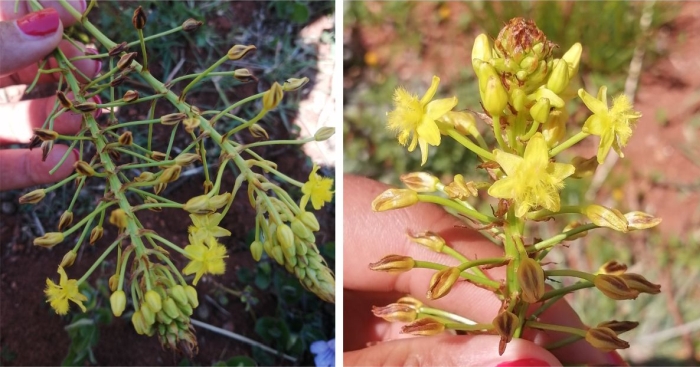
Description
Description
Bulbine capitata is a perennial succulent herb that grows 200–450 mm tall from a woody, rhizomatous base. The leaves are fleshy, grass-like and are overlapping at the base. This plant grows in clusters, with a flat-topped, spike-like inflorescence, up to 150 mm long, in spring (August to November). The flowers are sweetly scented, bright yellow, star-shaped, with densely bearded stamens. They start maturing from the bottom of the inflorescence, opening up to ten flowers at a time. Flowers and fruits occur together in the same raceme, the fruit is covered with a faded perianth cap, maturing from brownish to black. The clusters of plants die back in winter and resprout in spring. Bulbine capitata is closely related to Bulbine angustifolia and is sometimes confused with it, however Bulbine angustifolia is a taller plant, growing 500-750 mm high.
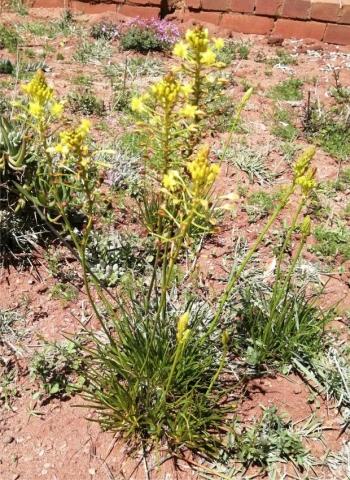
Conservation Status
Status
Bulbine capitata is not threatened and was given an automated status of Least Concern (LC) as it was not selected in any one of the four screening processes for highlighting potential taxa of conservation concern for detailed assessment.
Distribution and habitat
Distribution description
Bulbine capitata is distributed along the centre of South Africa moving up to the north. It is common in the summer rainfall regions: Free State, Gauteng, North-West, KwaZulu-Natal, Mpumalanga and Limpopo. It is also found in Eswatini, Lesotho, Zimbabwe, Botswana and Namibia. It grows in clusters in grassland, in sandy soil and on rocky hillsides.
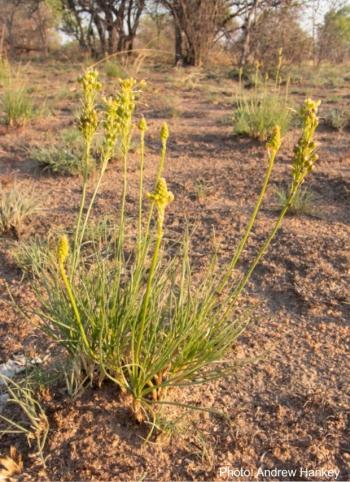
Derivation of name and historical aspects
History
The name of the genus Bulbine comes from the Latin word bulbus meaning ‘onion’ or ‘bulb’. The species name capitata is a Latin word which means ‘with a dense head’, referring to the compact inflorescences. Bulbine belongs in the Asphodelaceae, a family which consists of 40 genera and over 1 000 species worldwide. The genus Bulbine comprises ±73 species occurring in Africa and Australia. Whereas only 6 species are found in Australia, a total of 67 occur in southern Africa, with just 5 of these also extending into tropical Africa (Klopper 2007).

Ecology
Ecology
This plant is adapted well to survive fire because it grows in the grassland and is exposed to veld fires. The fleshy leaves resist burning to some extent, and even when burned, the plant usually survives because of its woody rhizome, which sends out new growth after the fire. Bulbine capitata is pollinated mainly by bees, to prevent cross pollination the plant can be covered with a net when it starts flowering.
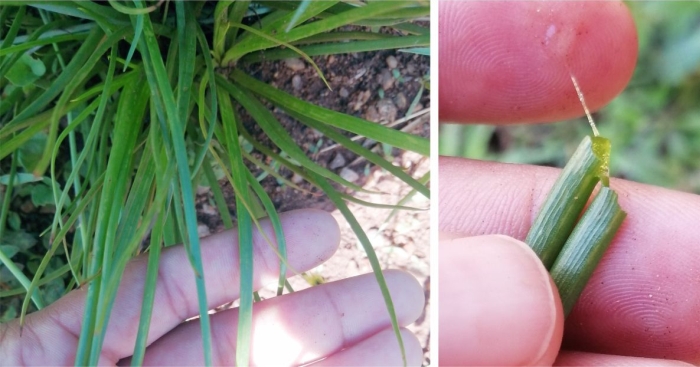
Uses
Use
The genus Bulbine is known for its traditional medicinal use, the fleshy leaves used to treat aliments such as skin diseases and burns, and the roots used to treat diarrhoea and sexually transmitted diseases. Bulbine capitata can also be used successfully in horticulture as a filler plant or groundcover, mass planted to show its beautiful yellow flowers to their best effect. This is a beautiful, sun-loving plant that can be planted in rock gardens, grassland gardens and waterwise gardens.

Growing Bulbine capitata
Grow
Propagate Bulbine capitata through vegetative propagation: when the plant has developed into a large clump, it can be lifted up and divided into smaller clumps. Transplant into well-drained, sandy soil, place it in full sun and water once a week or when it is necessary. Vegetative propagation is best done in spring, before it flowers.
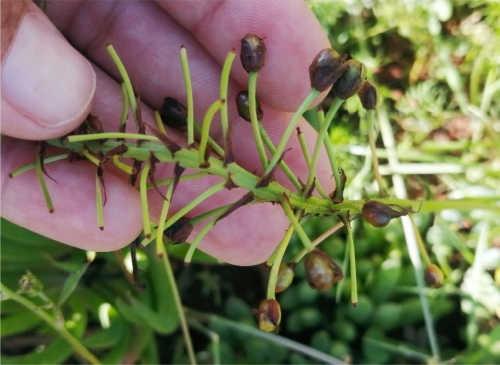
Bulbine capitata can also be propagated through seeds sown in its growing season, spring. Sow the seeds in a tray filled with well-drained, sandy soil, keep the soil moist until the seeds germinate. It should germinate within a week or so. When large enough to handle, the seedlings can be transplanted into pots, filled with sandy soil and placed in full sun and given minimum watering.
Plant Bulbine capitata in full sun, in well-drained sandy soil. It is perfect for waterwise gardens, grassland gardens and rock gardens, interplanted with a combination of other succulent plants.
References
- Eliovson, S. 1980. Wild flowers of southern Africa. MacMillan. Pretoria.
- Hankey, A. 2019. Observation of Bulbine capitata, Roodepoort, Gauteng. iNaturalist. Online. https://www.inaturalist.org/observations/33065086.
- Hankey, A. 2021. Observation of Bulbine capitata, Bojanala, North West. iNaturalist. Online. https://www.inaturalist.org/observations/98586946.
- Kativu, S. 2001. Bulbine capitata Poelln. Flora Zambesiaca 12(3): 25. Accessed via JSTOR, http://plants.jstor.org/stable/10.5555/al.ap.flora.fz9754.
- Klopper, R. 2007. Bulbine abyssinica A.Rich. (Asphodelaceae). PlantZAfrica. Online. http://pza.sanbi.org/bulbine-abyssinica.
- Klopper, R. 2007. Bulbine narcissifolia Salm-Dyck. (Asphodelaceae). PlantZAfrica. Online. http://pza.sanbi.org/bulbine-narcissifolia.
- Pooley, E. 2005. A field guide to wild flowers KwaZulu-Natal and the eastern region. The Flora Publications Trust, Durban.
- Raimondo, D., Von Staden, L., Foden, W., Victor, J.E., Helme, N.A., Turner, R.C., Kamundi, D.A. & Manyama, P.A. (eds) 2009. Red list of South African plants. Strelitzia 25. South African National Biodiversity Institute, Pretoria.
Credits
Rofhiwa Ingrid Mudau
Pretoria National Botanical Garden
November 2022
Plant Attributes:
Plant Type: Perennial, Succulent
SA Distribution: Free State, Gauteng, KwaZulu-Natal, Limpopo, Mpumalanga, North West
Soil type: Sandy, Loam
Flowering season: Spring
PH:
Flower colour: Yellow
Aspect: Full Sun
Gardening skill: Average
Special Features:
Horticultural zones








Rate this article
Article well written and informative
Rate this plant
Is this an interesting plant?
Login to add your Comment
Back to topNot registered yet? Click here to register.